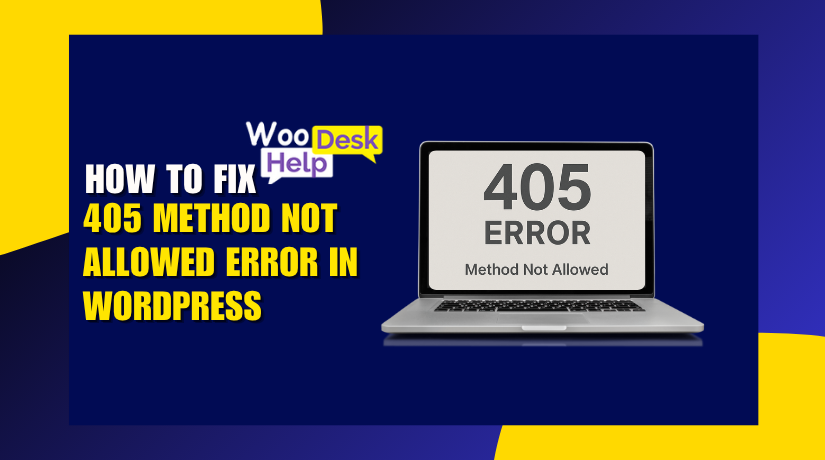
How to Fix 405 Method Not Allowed Error in WordPress
Table of Contents
- What Is the 405 Method Not Allowed Error?
- Common Variations of the 405 Method Not Allowed Error Message
- What Causes the 405 Method Not Allowed Error in WordPress?
- How to Fix 405 Method Not Allowed Error in WordPress
- Conclusion
What Is the 405 Method Not Allowed Error?
The 405 Method Not Allowed error WordPress is a type of HTTP response status code. It belongs to the 4xx client-side error category but often stems from server-side rules. Specifically, this error occurs when the browser sends a request using an HTTP method that the server understands but does not allow for the targeted resource. In other words, the resource exists, but the method of access is restricted, resulting in a 405 Method Not Allowed Error.
HTTP methods like GET, POST, PUT, and DELETE define how a request interacts with content. If the method used does not match the server’s allowed methods, the request is blocked. For example, submitting a POST request to a page that only permits GET will trigger this error. The server will respond by denying the method and sending a HTTP 405 Method Not Allowed Error to the browser.
This behavior is very different from a 404 Not Found error. A 404 means the URL is incorrect or the page is missing. But the 405 error WordPress confirms that the URL is valid and the page exists, yet the method used to access it is unacceptable. The client and server recognize each other, but the action requested is outside of what’s allowed by the configuration.
In WordPress, the error usually occurs when working with forms, plugins, custom themes, or REST API routes. You might see the WordPress post returns 405 Method Not Allowed message if a plugin attempts to update a post using an unsupported method. Similarly, AJAX requests in the admin area may also be blocked, especially if server settings are too strict or not properly configured.
The server responds by returning a status code like 405 Not Allowed, HTTP Error 405, or Method Not Allowed, depending on the configuration. These messages might appear on contact forms, product pages, or custom REST endpoints. The exact message depends on your server stack (Apache, NGINX, etc.) and your WordPress setup.
Although the 405 code is in the 4xx range, it’s often caused by server-side configurations rather than user mistakes. The problem can stem from firewalls, mod_security rules, or improper route handling within the theme or plugins. Misconfigured settings, such as unsupported HTTP verbs or missing Allow headers, often lead to the 405 Method Not Allowed error WordPress users encounter.
For developers and site owners, this error highlights a disconnect between expected and allowed HTTP behavior. That’s why it’s important to perform correct WordPress 405 error troubleshooting when it arises. Fixing it requires checking route definitions, plugin compatibility, server permissions, and API request methods. A clear understanding of how HTTP methods work is essential in resolving this issue.
Common Variations of the 405 Method Not Allowed Error Message
- 405 Method Not Allowed
This standard HTTP response indicates that the server recognizes the request method but does not permit it for the targeted resource. For instance, attempting a POST request on a resource that only allows GET will trigger this error. It’s a clear sign of method restriction at the server level.
- HTTP 405 Method Not Allowed
This variation includes the protocol prefix, emphasizing that the error is rooted in HTTP protocol constraints. It often appears in browser consoles or API responses, signaling that while the server understands the method, it’s not allowed for the specific resource. This is common in RESTful API interactions.
- 405 Not Allowed
A more concise version, this message omits the method detail but conveys the same restriction. It’s typically displayed in user-facing error pages, indicating that the attempted action is not permitted. Developers should inspect server configurations to identify disallowed methods for the requested resource.
- Method Not Allowed
This generic message is often returned by servers without specifying the HTTP status code. It indicates that the request method is not supported for the requested resource. Developers should refer to server logs or documentation to determine which methods are permitted for the endpoint.
- HTTP Error 405
This format is commonly used in browser error pages, combining the protocol and error code. It signifies that the server received the request but refuses to authorize the method used. This often results from misconfigured server settings or incorrect client requests.
- HTTP Error 405 – Method Not Allowed
An extended version providing both the error code and its description. This detailed message aids in debugging by clearly stating the nature of the error. It’s frequently encountered in web applications when a client uses an unsupported HTTP method for a specific endpoint.
- 405 – HTTP verb used to access this page is not allowed
This message specifies that the HTTP verb (method) used is not permitted for the requested page. It’s often seen in applications with strict method handling, such as ASP.NET, where certain verbs are restricted for security or design reasons.
- 405 Method Not Allowed – The specified HTTP method is not allowed for the requested resource
A verbose description that explicitly states the issue: the HTTP method used is not permitted for the target resource. This message is helpful for developers to understand that while the resource exists, the method of access is inappropriate.
- 405 Method Not Allowed – HTTP method not supported for this endpoint
This variation is common in RESTful APIs, indicating that the endpoint does not support the HTTP method used in the request. Developers should consult the API documentation to determine the correct methods allowed for each endpoint.
- 405 Method Not Allowed – The method is not allowed for the requested URL
This message highlights that the method used is not permitted for the specific URL requested. It’s often encountered when clients attempt operations like PUT or DELETE on endpoints that only support GET or POST. Proper method usage is essential to avoid this error.
What Causes the 405 Method Not Allowed Error in WordPress?
The 405 Method Not Allowed error in WordPress occurs when the server recognizes the HTTP method used in a request but does not allow it for the requested resource. This can result from various issues, including plugin conflicts, incorrect configurations, or server restrictions. Understanding these causes is essential for effective troubleshooting.
- Plugin Conflicts
Conflicting plugins can trigger the WordPress 405 Method Not Allowed error. Some plugins may send HTTP requests using methods like PUT or DELETE, which the server might block. To identify the culprit, deactivate all plugins and reactivate them one by one, checking for the error after each activation. This process helps pinpoint the plugin causing the issue.
- Corrupted .htaccess File
A misconfigured or corrupted .htaccess file can lead to a 405 Method Not Allowed due to .htaccess rules. This file controls how URLs are handled on your site. Incorrect directives can block certain HTTP methods. Restoring the default .htaccess file or correcting the directives can resolve the error.
- Incorrect HTTP Method Usage
Using an unsupported HTTP method for a specific URL can cause a 405 error WordPress due to wrong HTTP method. For instance, sending a POST request to a URL that only accepts GET requests will result in this error. Ensure that the HTTP method used matches what the server expects for the resource.
- Security Plugin Restrictions
Security plugins may block certain HTTP methods to protect your site, leading to a 405 error due to WordPress security plugin. These plugins might restrict methods like PUT or DELETE. Review your security plugin settings to adjust or whitelist the necessary methods to prevent this error.
- Theme Function Issues
Custom functions in your theme’s functions.php file can interfere with HTTP requests, causing a 405 Method Not Allowed due to theme functions. These functions might unintentionally block specific methods. Switching to a default theme can help determine if the issue lies within your theme’s functions.
- Blocked REST API Endpoints
If the REST API endpoints are blocked or misconfigured, you may encounter a 405 error in WordPress due to REST API block. This can happen if plugins or themes restrict access to the REST API. Ensure that the REST API is accessible and properly configured to handle the intended HTTP methods.
- Cloudflare Firewall Settings
Cloudflare’s security settings can sometimes block legitimate HTTP methods, resulting in a 405 error due to Cloudflare settings in WordPress. Features like the Web Application Firewall (WAF) may restrict methods like PUT or DELETE. Review and adjust your Cloudflare settings to allow the necessary HTTP methods.
- NGINX Server Configuration
Improper NGINX server configurations can cause a 405 Method Not Allowed due to NGINX config. Directives like limit_except may block certain methods. Review your NGINX configuration files to ensure that the necessary HTTP methods are permitted for your site’s resources.
- Server-Level Restrictions
Hosting providers may implement server-level restrictions that block specific HTTP methods, leading to a 405 error WordPress due to server restrictions. These restrictions are often in place for security reasons. Contact your hosting provider to inquire about any such limitations and request adjustments if necessary.
- Incorrect URL Usage
Accessing a resource with an incorrect URL can result in a WordPress 405 Method Not Allowed due to wrong URL. Even if the URL exists, using the wrong HTTP method for that URL will cause this error. Double-check the URL and ensure that you’re using the correct method for the resource.
- File Permission Issues
Incorrect file or directory permissions can prevent the server from executing certain HTTP methods, causing a 405 error due to missing permissions WordPress. Ensure that your files and directories have the appropriate permissions, typically 644 for files and 755 for directories. Adjust permissions as needed to resolve the error.
- AJAX Request Failures in Admin
AJAX requests in the WordPress admin area can fail if they use unsupported HTTP methods, leading to a WordPress admin 405 error due to AJAX request. This can be due to plugin conflicts or incorrect request configurations. Inspect and correct the AJAX request methods to match what the server allows.
How to Fix 405 Method Not Allowed Error in WordPress
The 405 Method Not Allowed error in WordPress can appear suddenly and confuse both beginners and developers. It occurs when a browser tries to access a page or resource using a method that the server does not allow. Here is a complete step-by-step guide with technical insights to help you fix it.
- Double-Check the URL for Typos
A small mistake in the URL can trigger this error. Double-check the spelling and structure of your URL. Make sure there are no extra slashes or wrong extensions. Even a minor typo can make the server deny access to that resource.
- Reload the Page or Use Incognito Mode
Your browser may be caching outdated requests. Reload the page or open it in an incognito window. This bypasses cached content and helps you identify whether the issue lies with your browser or the website configuration.
- Restore a Recent WordPress Backup
If the error started after recent changes, revert to a working backup. Use your hosting panel or a backup plugin to restore the site. This method helps you undo harmful changes made by themes, plugins, or manual code edits.
- Deactivate All Plugins
Faulty plugins often interfere with HTTP methods. Log in to WordPress and deactivate all plugins at once. Then, activate them one by one while checking the site. This helps isolate the plugin causing the problem and allows safe removal or replacement.
- Switch to a Default WordPress Theme
Themes can contain scripts that misuse request methods. Switch to a default theme like Twenty Twenty-Four. If the issue resolves, your previous theme had issues. You can debug or consider using an alternate, stable theme.
- Check for Unexpected Database Changes
Some plugins inject unwanted entries into your database. Access phpMyAdmin and inspect critical tables like wp_options, wp_users, and wp_posts. Roll back any recent suspicious changes. Always back up your database before making edits manually.
- Reset Recent WordPress Updates
WordPress updates may cause incompatibilities. Use a plugin like WP Rollback or your hosting backup tool to revert recent updates. This test helps determine whether a core update triggered the 405 error on your WordPress site.
- Review .htaccess File for Rewrite Rules
Faulty rewrite rules in .htaccess can block specific request types. Use FTP to locate .htaccess in the root folder. Back it up first. Remove or comment out rewrite directives mentioning 405. Save changes and reload your website.
- Examine Server Configuration (Apache or NGINX)
Server config files might limit request methods. For Apache, review .htaccess. For NGINX, check nginx.conf. Look for location blocks or method restrictions. Remove unnecessary constraints and restart the web server to apply the changes.
- Adjust File and Folder Permissions
Incorrect permissions block execution of certain scripts. WordPress folders should have 755 and files 644 permissions. Use an FTP client or hosting file manager to reset them. Some control panels also offer built-in permission reset tools.
- Enable Debug Mode in WordPress
Debug mode logs PHP errors that help detect faults. Edit wp-config.php and set WP_DEBUG to true. Then, check the debug.log file inside wp-content. Analyze recent logs for entries related to forbidden requests or plugins.
- Review Server-Side Logs
Hosting logs provide valuable clues about server behavior. Access logs show request paths and response codes. Error logs show rejected requests and why. Review logs using your hosting dashboard or cPanel to trace the exact reason behind the 405 error.
- Check for Custom Code or Script Errors
Custom scripts may use disallowed HTTP methods. Review your code, especially in AJAX handlers and forms. If POST, PUT, or DELETE requests are used incorrectly, replace or fix them. Always test scripts in a staging environment before live deployment.
- Reset Permalinks in WordPress
Broken permalinks may redirect requests incorrectly. Go to Settings > Permalinks in the dashboard. Click “Save Changes” without modifying anything. This regenerates the .htaccess file with default rules and may fix method-related errors instantly.
- Scan .htaccess for Additional Rewrite Rules
Check if any subdirectory has its own .htaccess file. These may override the main one. Look for rules affecting request methods. Clean or remove unnecessary directives that handle HTTP verbs like POST or DELETE.
- Test Your DNS A Records
Incorrect DNS can send users to the wrong server. Access your DNS settings and check the A record for your domain. It must point to your actual server IP. Fixing this ensures requests reach the correct host environment.
- Fully Restore Website from Clean Backup
If all else fails, restore a complete site backup. This ensures no corrupted files or scripts remain. Choose a backup from a stable period. Use your hosting backup manager or plugins like UpdraftPlus for a full restoration.
- Contact Your Web Hosting Provider
When nothing works, reach out to support. Hosting providers have deeper access to server configurations and logs. They can detect server-side rules or security policies blocking certain HTTP methods. Request detailed diagnostics or assistance.
Conclusion
The 405 Method Not Allowed error in WordPress typically occurs when an HTTP request method, such as POST or DELETE, is disallowed by the server for a specific endpoint. It often stems from misconfigured .htaccess rules, plugin conflicts, or strict server security policies. By systematically troubleshooting—from verifying URL structures and resetting permalinks to inspecting server logs and reviewing REST API routes—you can isolate and resolve the issue. Understanding how HTTP methods interact with your server environment is key. If standard fixes fail, server-level adjustments or expert assistance may be required to restore full site functionality.




